I resist using the term “Metroidvania” when I write about videogames. Reducing a videogame to a more popular one is efficient for relaying an idea but is also fraught with problems. First, it assumes all readers have played Metroid or Castlevania. Second, I have to explain what makes it unique from a baseline when describing what makes something unique is a review’s job to begin with; it’s extraneous. Third, it generalizes Metroid and Castlevania into being equivalents with nothing that makes them unique. Fourth, it’s lazy. I could refer to Blasphemous as a Metroidvania in my review but I would be doing a disservice to Blasphemous, to Metroid, and to Castlevania if I did. The same holds true for Bug Fables: The Everlasting Sapling, an RPG from indie studio Moonsprout Games. It’s inspired by Paper Mario, particularly in its visual aesthetic of paper-thin characters exploring a polygonal environment, but the sum total of its parts add up to a very different videogame than the Nintendo 64 classic or its sequels.
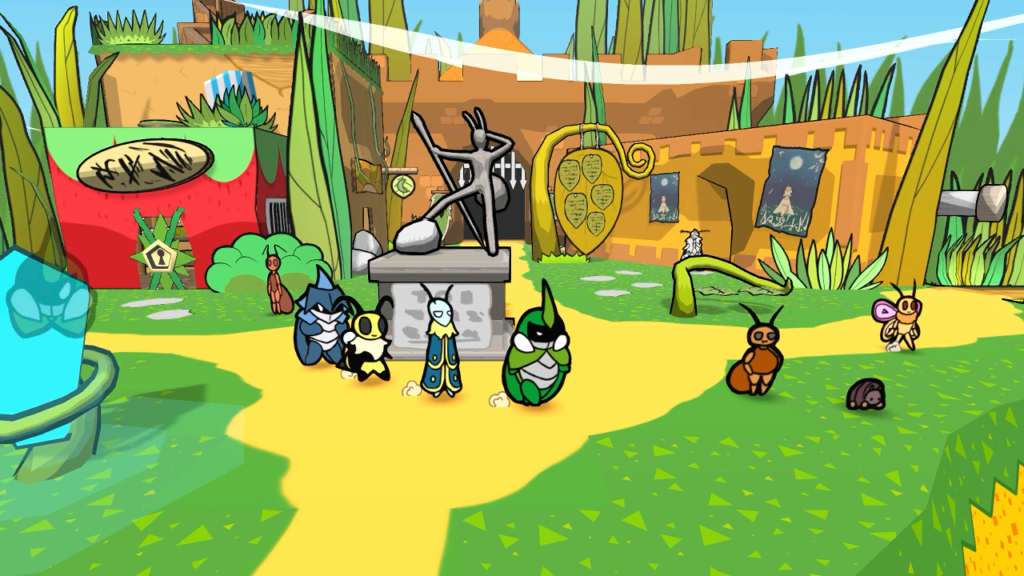
Bug Fables is set in a world where many insect species achieved sentience after the Day of Awakening. Awakened insects gained speech, extended lifespans, and bipedal motion; solitary insects developed close-knit family units, while social ones established kingdoms with queens, soldiers, and civilian classes. One such kingdom was founded by Queen Elizant I, who settled in a land called Bugaria because of a local legend about an Everlasting Sapling whose leaves grant eternal life when eaten.
As Bug Fables opens, Elizant I has fallen into an enchanted sleep and her daughter Elizant II has succeeded her as queen. Hoping some day to revive her mother, Elizant II sponsors an Explorers’ Association to scour Bugaria for the Everlasting Sapling. Circumstances force two bugs, Vi the honey bee and Kabbu the horned beetle, to form an impromptu team. They soon rescue Leif, a moth with inexplicable ice magic, from the dangerous Snakemouth Den, who joins the duo. At first dismissed as upstarts, the newly-dubbed Team Snakemouth upsets the Explorers’ Association and upends the politics of Bugaria on their quest to find the Everlasting Sapling.
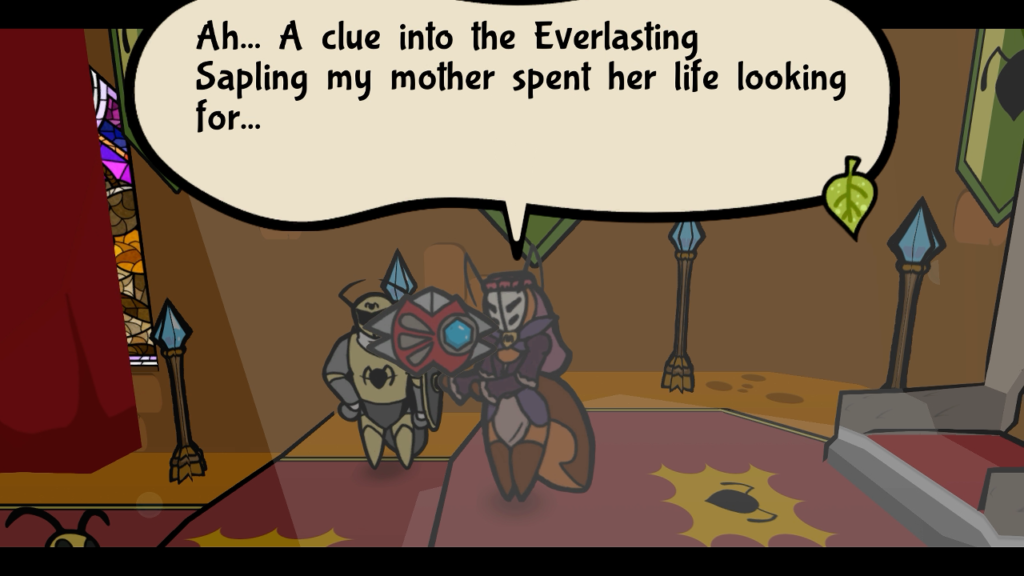
One of Bug Fables’ strengths is the depth of its characters and setting. In too many videogames I play, characters are exactly who they appear to be when I first meet them—especially player characters. Though I meet Vi and Kabbu at the start of their relationship with the Explorers’ Association, they are already midway on personal journeys that brought them to the Ant Kingdom, and I learn more about their troubled histories as I explore Bugaria. They’re nothing compared to Leif, whose traumatic backstory I learn if I finish his optional personal sidequest. Non-player characters receive a similar treatment; my bad first impressions of Elizant II, the ant queen, and Zasp, a rival Explorer, change as I learn more about their motivations and they grow as people through their interactions with Team Snakemouth.
Bugaria is rich with history as well. The Ant Kingdom, while appearing cosmopolitan, has rocky relations with its neighboring kingdoms which impact Team Snakemouth’s quest. And while Bugaria’s true nature is revealed early on—it’s exactly what you’re thinking it is—the origins of the Day of Awakening and this world of sentient insects goes unexplained. Bug Fables reveals just enough of its setting to tell Team Snakemouth’s story, hinting at other fables but not examining them, creating an enticing possibility for future installments set in Bugaria.

Bug Fables is quite unlike Paper Mario in terms of its plot and characters, but its combat systems appear beholden to Mario’s most famous RPG outing. Team Snakemouth engages in turn-based combat with hostile bugs they encounter during their quest, sustained by hit point meters and sharing an energy pool to power their most fantastic abilities.
Each Team Snakemouth member has unique basic attacks which are more or less effective against different types of enemies. Kabbu’s sharp horn can pierce through the toughest defenses, but can only hit grounded enemies and those at the front of the group. Vi’s Beemerang is weak, but can hit any enemy and knocks flying or hanging enemies to the ground. Leif can also target any enemy and their ice magic can strike bugs that have burrowed into the ground.
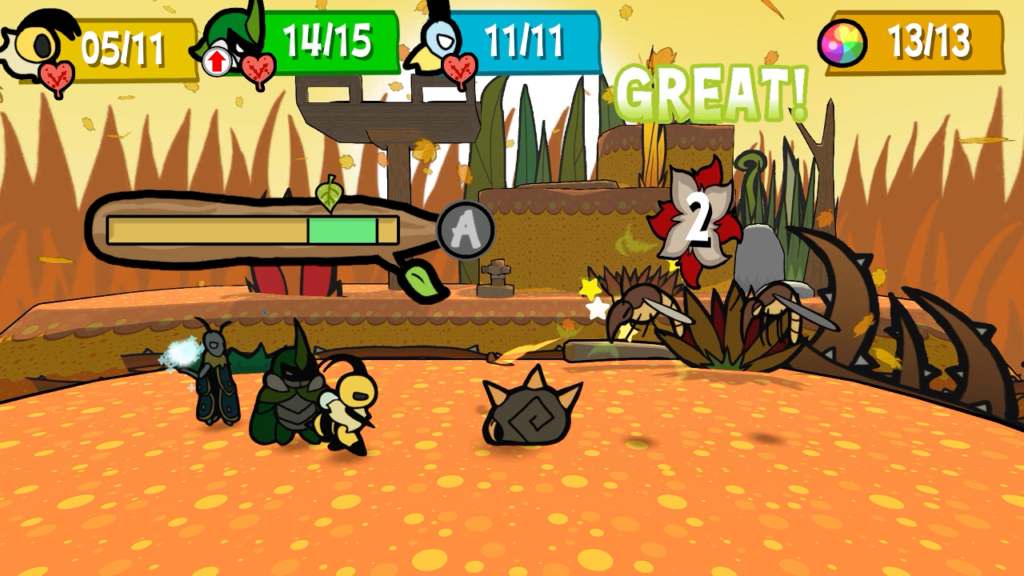
All of these attacks can be powered up through an action command. To power up Kabbu’s attack, I must hold a direction on the joystick then release when an icon lights up. Vi’s Beemerang powers up when I stop a slider within a highlighted zone. Leif’s ice magic powers up when I press a random button which is revealed for a split-second after a countdown. Similar button pressing activities also reduce the damage Team Snakemouth takes in combat. All of these mechanics are ripped straight from Paper Mario.
While Bug Fables borrows these mechanics, the underlying strategy I must employ when using them is different from their origin, especially on hard difficulty. This is due to the stringent limits on how I can upgrade Team Snakemouth. Paper Mario provides its hero with a generous five extra hit points every time I improve that attribute upon a level up, rising to fifty or more hit points by the endgame; Bug Fables gives each Team Snakemouth member a single hit point every time I improve that attribute. Since enemies often deal three or more damage with each hit and can hit multiple times in a single turn, one extra hit point doesn’t help much.
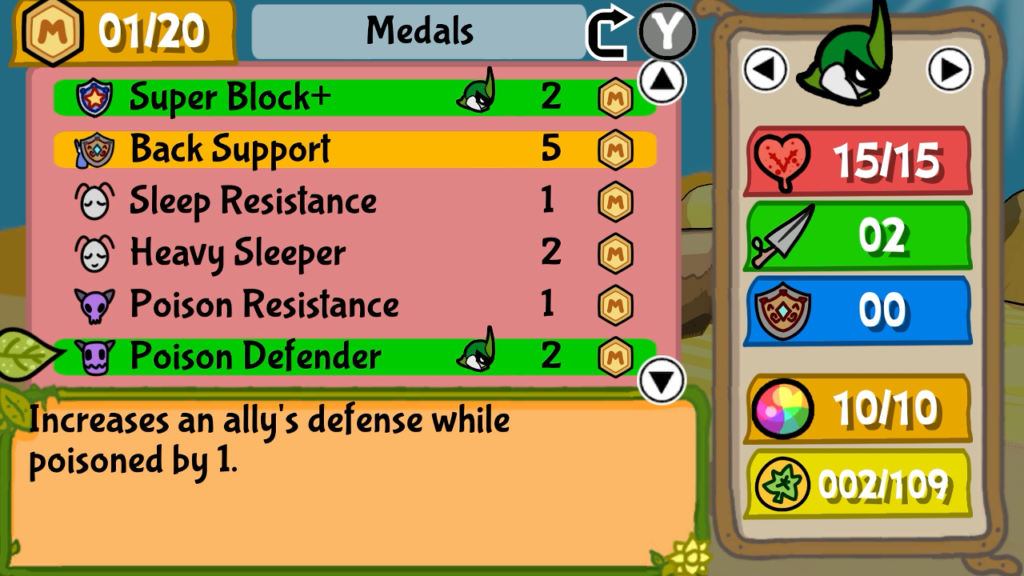
A much wiser use of limited development points is increasing Team Snakemouth’s Medal Points. Found hidden around Bugaria, obtained from sidequests, or looted from bosses, Medals are equipped to a Team Snakemouth member to augment their stats or abilities. More powerful medals take more Medal Points to equip. Choosing to improve the team’s Medal Points on a level up provides a respectable three points, providing potential immunity to a status effect, reducing the damage a character takes, or improving the efficacy of a skill or attack—and yes, this system is pulled from Paper Mario.
If I have made Bug Fables sound impossibly difficult with its heroes dying to a single enemy attack, then I have done it a disservice as its hard difficulty is among the most superbly balanced I have ever played. The quirks of its combat system provide challenge but not punishment. I found what few hit points I had scraped together was just enough to survive the next boss encounter through thoughtful application of Leif’s freezing magic and skillful defense timing to block enemy attacks. Boss battles are tough, but allow me to restart as many times as I need to clear it.
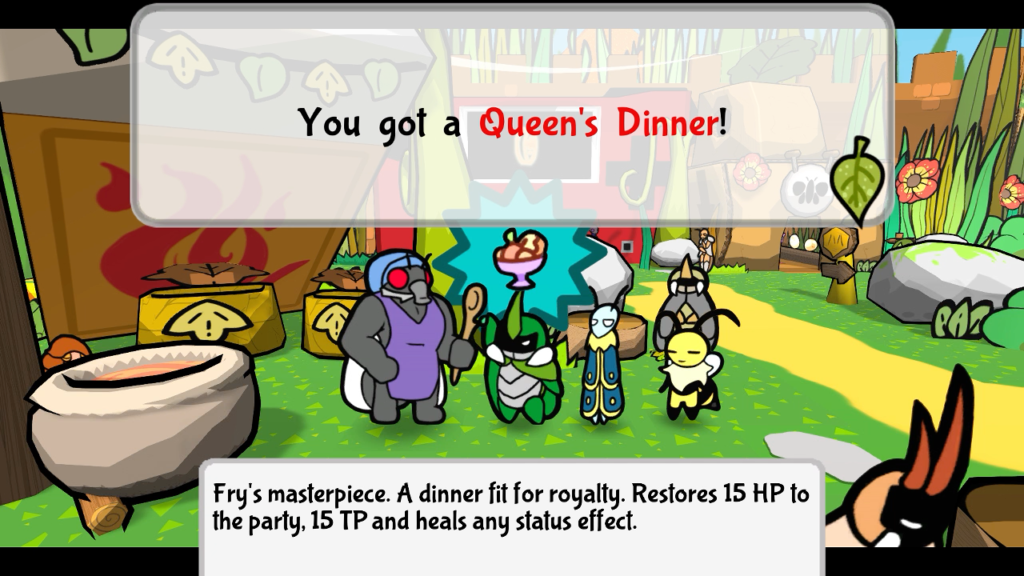
If I feel one consistent frustration with Bug Fables’ combat systems, it’s in healing. The few healing abilities Vi learns are useless, recovering less damage than her teammate has just taken and using up scarce Teamwork Points that Leif needs to keep dangerous enemies frozen. Worse, they cannot be used outside of combat. I was forced to use much more powerful healing items which are created by bringing two weaker items to a chef NPC in town—again, a system ripped straight out of Paper Mario. Stopping the quest every few hours to spend ten minutes buying items and cooking them into better items grew grating, but was impossible to avoid.
Bug Fables’ combat systems appear beholden to Paper Mario, but a spare approach to how character attributes improve creates a different experience demanding my smartest strategy and best timing. Frustrations about healing options aside, it provides some of the best-balanced and rewarding RPG combat I’ve experienced in some time, challenging but not impossible with effort.
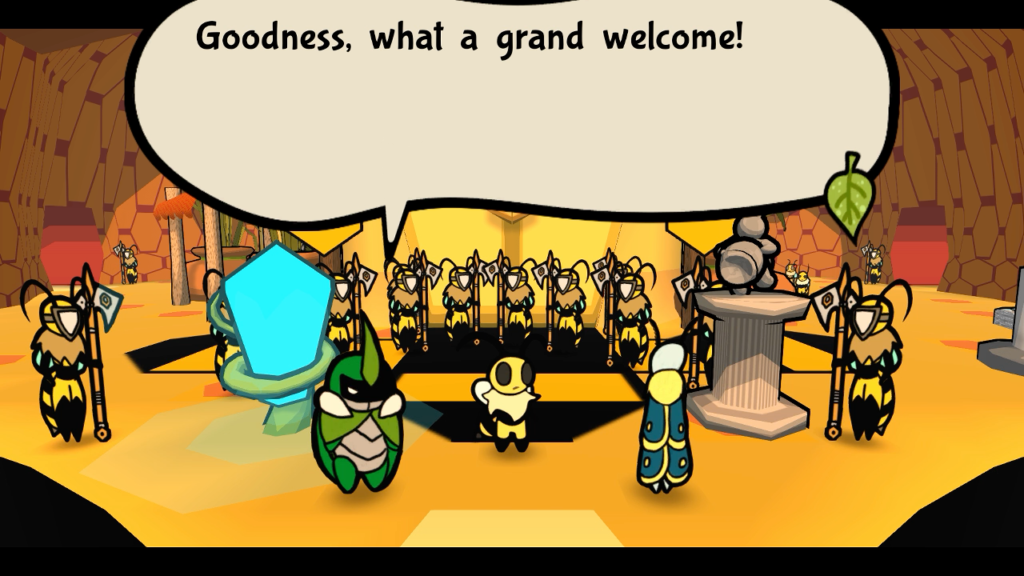
These battles take place across Bugaria as Team Snakemouth quests for the Everlasting Sapling. Basing themselves out of the Ant Kingdom at Bugaria’s center, they travel to its neighboring regions in seven chapters. Bugaria has a predictable but varied topography, from the Golden Hills where the Bee Kingdom’s subjects cultivate fertile farmland blessed by the Flower Goddess Venus, to the cylindrical Metal Lake with the Disneyland-like Metal Island at its center, to the desolate Forsaken Lands, a grey waste where bugs either discover the technologically advanced Termite Kingdom or are lost forever in the swirling mists. Following each chapter is a brief interlude where I return to the Ant Kingdom hub to purchase more powerful items, meet new characters, and learn where Team Snakemouth’s journey will take them next.
The more interesting thing that occurs during these interludes are sidequests. Posted on a board in the center of town, many are standard fetch quests, but some explore the histories of Team Snakemouth and their associates. The most interesting ones take me to obscure and optional corners of Bugaria to challenge its most fearsome enemies, pushing my skill and tactics further than even the final boss at the plot’s climax. Not all sidequests are winners, but they do an effective job of enriching and enlivening Bugaria and its denizens, and I don’t resent their inclusion in Bug Fables.
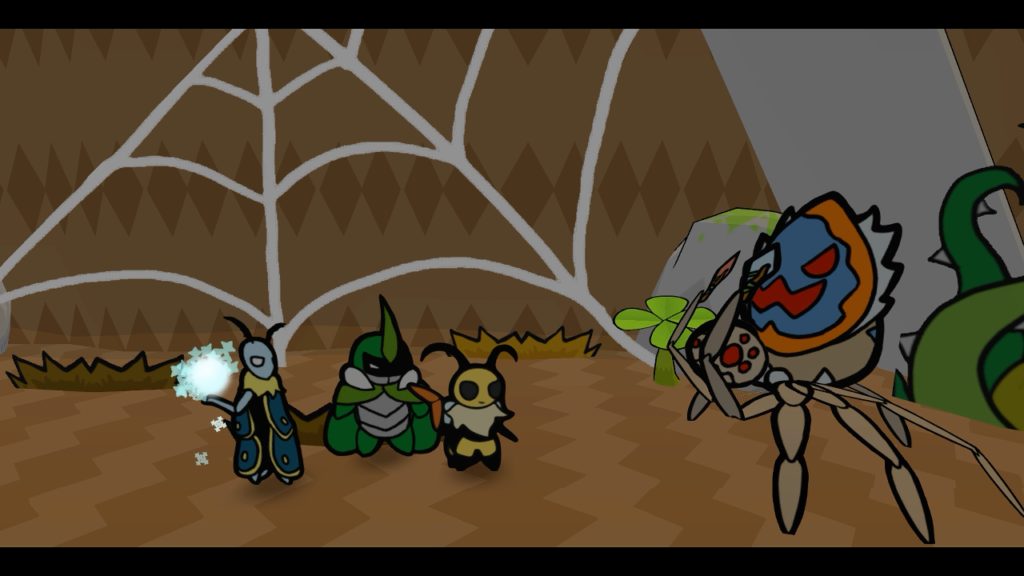
Bug Fables’ weakest aspect is the platforming and puzzle-solving that fills in the world between battles and story beats. Videogames that combine sprites and polygons often struggle with intuitive movement and jumping, and Bug Fables is no exception. It’s not always clear where characters are standing which can make accurate jumping difficult. Luckily platforming is low-stakes, tumbles into pits warping Team Snakemouth back to their last solid grounding with no penalties. There are few complicated jumping sequences, so it’s a minor complaint overall.
A more severe complaint comes from using Team Snakemouth’s unique abilities to solve puzzles. Kabbu can ram objects with his horn to move them across the environment; the ability is difficult to aim with the precision needed to push an object onto a switch and objects hop frustratingly short distances, forcing many, many uses of the skill to solve a puzzle. Vi’s Beemerang can activate windmill-like switches; the activation only works at the Beemerang’s maximum range and it has no reticle, requiring much repositioning to do something as simple as activate a switch. Leif’s ice magic can create blocks of ice on land and in the water, creating more chances to experience unwieldy object pushing and platforming. Some of Bug Fables’ puzzles are quite clever, but constant annoyance caused by finicky mechanics can turn them into chores.
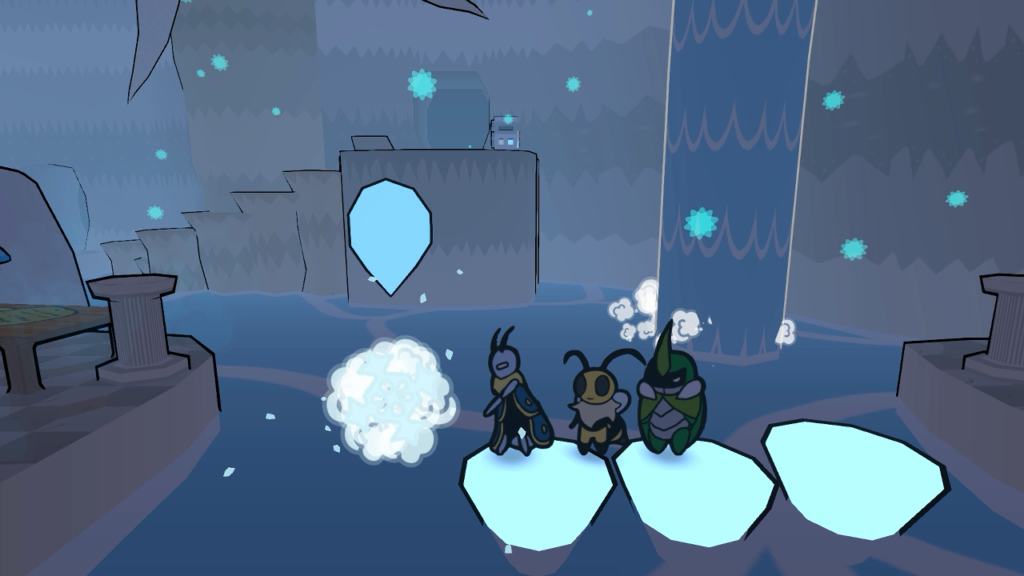
If you’re a fan of the first two entries in the Paper Mario series and have been disappointed by its more recent pseudo-RPG installments, then you will enjoy Bug Fables: The Everlasting Sapling. But to acknowledge it solely as an indie remake of Paper Mario, to reduce it to a glorified fangame, is to ignore its detailed world, its sympathetic characters, and the refinements made to Paper Mario’s too-easy combat mechanics. It’s not a videogame only Paper Mario fans will enjoy. Anyone interested in a deep world and smart RPG mechanics will find a lot to love here.